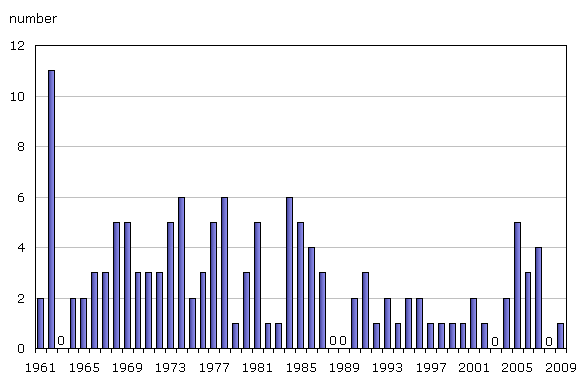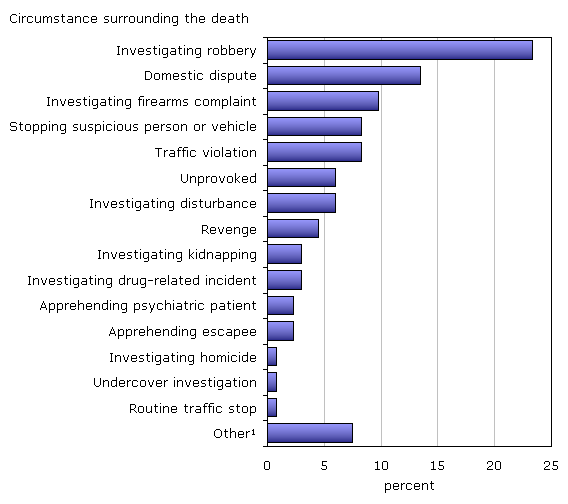Police officers murdered in the line of duty, 1961 to 2009
Archived Content
Information identified as archived is provided for reference, research or recordkeeping purposes. It is not subject to the Government of Canada Web Standards and has not been altered or updated since it was archived. Please "contact us" to request a format other than those available.
by Sara Dunn
Policing, by its very nature, is a high-risk occupation. One of the dangers associated with being a police officer1 in Canada is homicide. The only other profession more at risk of on-the-job homicide is that of taxi drivers with a rate about twice that of police officers.2
Drawing on data from the Homicide Survey, this article presents information on police officers who were murdered in the line of duty since 1961. It does not include police officers who were killed as a result of other causes, such as traffic accidents.
Between 1961 and 2009, 133 police officers were murdered in the line of duty–including eight double, one triple and one quadruple-slaying. Most of these deaths (65%) occurred in the first half of this time period, between 1961 and 1984 (Chart 1).
Homicides against police officers have occurred in every province and territory with the exception of Prince Edward Island and Yukon (Table 1).
Chart 1
Homicides against police officers, Canada, 1961 to 2009

Source: Statistics Canada, Canadian Centre for Justice Statistics, Homicide Survey.
Robbery investigations most dangerous for police
There are some situations faced by police officers in which the risk of being murdered is higher than others. For example, since 1961, police officers were most often murdered during a robbery investigation, accounting for nearly one-quarter (23%) of all killings (Chart 2). Another 14% of police officers were murdered while responding to a domestic dispute, although most of these homicides occurred during the 1960s and 1970s. In more recent years, stopping a suspicious vehicle/person and stopping a vehicle for a traffic violation have resulted in more homicides against police officers than responding to domestic disputes.
There has been some debate within the policing community surrounding the issue of one-person versus two-person vehicle patrols. Of those officers killed while on vehicle patrol, 54% were assigned to two-officer vehicles and 46% to one-officer vehicles.
Chart 2
Homicides against police officers, by type of circumstance, Canada, 1961 to 2009

1. Includes all other situations not otherwise stated. For example, riot control, suicide situations, investigations of criminal incidents not listed above.
Source: Statistics Canada, Canadian Centre for Justice Statistics, Homicide Survey.
One-third of murdered officers relatively new to their service
Between 1961 and 2009 all but four police officer homicides were against males, many of whom were relatively new to their present police service. On average, murdered police officers were 34 years old at the time of their death and had been with their present police service for less than 5 years.
Similar to homicides in general, the vast majority (95%) of those accused of killing a police officer were male, averaging about 30 years of age. Of the 170 people accused of homicide against a police officer since 1961, nine were female and three were youth (12 to 17 years). Unlike overall homicides, those against police officers were more than twice as likely to involve multiple accused persons (30% versus 12%).
Police officers most commonly murdered with a firearm
Police officers killed in the line of duty were almost invariably shot to death. Between 1961 and 2009, 92% of all officer-related killings were committed with a firearm. Of these, rifles or shotguns (including sawed-off) accounted for 56% of deaths while handguns were used in 44% of these killings. Nearly 8 in 10 officers were not wearing protective body armour (such as vests) at the time of the shooting, although this was more commonly the case in the 1960s and 1970s.
Most police officers did not have an opportunity to defend themselves–about one-third of officers drew or fired their weapon before being killed.
Most homicides against police officers are solved
In general, most homicides are solved but this is particularly the case when the victim is a police officer. Of all homicides against police officers since 1961, 96%, or all but five killings, have resulted in an accused person being identified. In comparison, 84% of homicides in general have been solved over this same period.
Detailed data table
Table 1 Homicides against police officers by province and territory, 1961 to 2009
Notes
- Police officers include those persons employed for the preservation and maintenance of the public peace or for the service or execution of civil process. This category does not include correctional officers or private security personnel.
- Based upon data beginning in 1991 when estimates of population data by occupation became available from the Census. Excludes "occupations" that involve illegal activities (for example, prostitutes, gang members and drug dealers).
- Date modified:
